 |
 |
You can add soffritto to anything: burgers, pasta, sauces, stir-frys and a long list below. Photo by Medusa Photography | Dreamstime. |
| WHAT IT IS: An Italian and Latino cooking condiment made of diced vegetables—typically carrots, celery, garlic and onions—sautéed in olive oil. |
| WHY IT’S DIFFERENT: You can make it in advance—or open a jar of purchased soffritto—and add “instant” great flavor to most savory dishes. |
WHY WE LOVE IT: It’s an easy, quick and healthful way to flavor food. |
| WHERE TO BUY IT: At retailers nationwide and online. See company website, NonnaIolesSoffritto.com. |
|
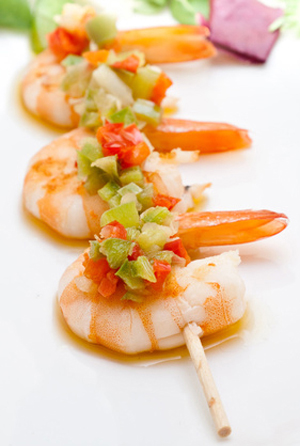
Cooked shrimp topped with soffritto. Photo © Miunica Neurona | Fotolia.
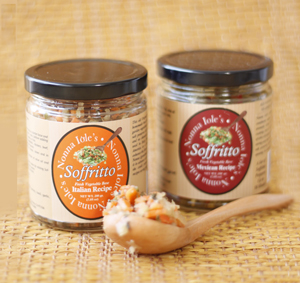
Nonna Iole’s Soffritto is made in two flavors: Italian Recipe and Mexican Recipe. Photo by Elvira Kalviste | THE NIBBLE. |
|
Nonna Iole’s Soffritto: A Classic Way To Add Flavor To Your Dishes
Jump to the article index below
In French cuisine, many recipes begin with a mirepoix* (MEER-uh-PWAH), a combination of chopped carrots, celery and onions also known as aromatics. They are added raw, roasted or sautéed to sauces, soups, stews and stocks.
In Italian and Latin cuisine, the analogous ingredient is soffritto: minced vegetables and aromatic herbs cooked in extra virgin olive oil. The name means “fry slowly.”
This healthful cooking ingredient—helps to enhance the flavor of many dishes. The basic recipe combines carrots, celery, garlic, onions, salt and sometimes a splash of white wine vinegar. Similar preparations† are popular in other cuisines.
Soffritto saves prep time in the kitchen. A batch is made in advance; perhaps a week’s worth to be used in daily cooking.
If you don’t want to make it yourself, you can buy a jar of Nonna Iole’s Soffrito.
A supply of soffrito makes it quick and easy to prepare more interesting meals. You can find a way to use soffritto every day:
- Beans: Cook beans and then sauté with soffritto.
- Condiment: Spoon soffritto atop cooked foods like a coulis or relish (see photo of shrimp, below). For a sandwich spread, mix into mayonnaise.
- Dips: Mix into plain yogurt, sour cream or your favorite base.
- Eggs: Mix into scrambled eggs or omelets.
- Marinades: Marinate meat/fish in two teaspoons of soffritto mixed with olive oil and either lemon juice or white wine. Then grill or bake.
- Meat/Fish, Baked: Mix 2 teaspoons of soffritto with 1 tablespoon olive oil; spoon over meat/fish. Add ½ cup white wine to pan and bake.
- Meat, Ground: Mix soffritto into beef or turkey burgers, meat loaf, meat balls: 2 teaspoons per pound of ground meat.
- Meat, Roasted Or Stewed. Brush 1 teaspoon soffritto over the roast. Add 2 teaspoons soffritto to the roasting pan to brown, along with 2 tablespoons olive oil and one bay leaf (do this with stews as well).
- Rice: Add soffritto to rice pilaf, risotto or Spanish rice.
- Sautés/Stir Frys: With fish, meat, vegetarian or vegan ingredients, add 1-2 teaspoons to the pan with 1 tablespoon olive oil. Sauté 1 minute. Add cooking ingredients and sauté or stir fry, covered, for few minutes.
- Sauces: As a base for tomato-based pasta sauces, or mixed into olive oil for a vegetable sauce.
- Soups: Add to the base.
Nonna Iole’s Soffritto
You don’t have to make your own soffritto; you can buy it from Nonna Iole—it’s Grandma (Nonna) Iole’s recipe. Nonna Iole’s follows a familiar path: Friends and family members clamored for jars of soffritto and Iole’s daughter, Lorena Guma-Stephenson, began to produce it commercially. She makes it in two flavors:
- Italian Recipe with basil, carrots, celery, garlic, Italian parsley, onions and sea salt.
- Mexican Recipe with bell peppers, cilantro, garlic, jalapeños, tomatoes and sea salt.
Buy a jar and experience the savory goodness of soffrito. There’s a recipe for homemade soffritto below.
— Karen Hochman
* Like pralines and numerous other French creations, mirepoix is named for an aristocrat whose chef formalized and popularized the recipe. In the case of mirepoix, credit goes to the unnamed chef of Charles-Pierre-Gaston François de Lévis, duc de Lévis-Mirepoix (1699–1757).
† There are similar mixtures in other cuisines: holy trinity in Creole cooking (the same ingredients), refogado in Portugal (braised onions, garlic and tomato), suppengrün in Germany (soup greens: carrot, celeriac and leek), woszczyzna in Poland (cabbage, carrot, celeriac, leek, parsley root and parsnip). |
Get Cooking With Soffritto!
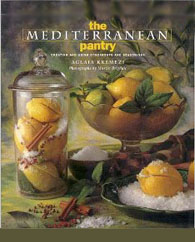 |
|
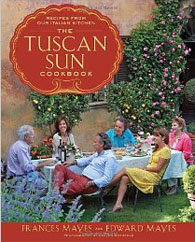 |
|
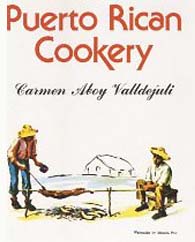 |
The Mediterranean Pantry: Creating and Using Condiments and Seasonings, by Aglaia Kremezi. Delicious recipes for unusual and familiar condiments: preserves, flavored oils and vinegars, liqueurs and spice and herb mixtures. More information.
|
|
The Tuscan Sun Cookbook: Recipes from Our Italian Kitchen, by Frances Mayes and Edward Mayes. Great recipes, beautiful photographs and interesting stories surrounding them. Perfect for an Italian food lover. More information. |
|
Puerto Rican Cookery, by Carmen Aboy Valldejuli. The classic guide to a cuisine that uses lots of soffrito. Mrs. Valldejuli was the foremost authority on Puerto Rican cooking. Her recipes bring the flavor of the island to your table. More information.
|
INDEX OF REVIEW
This is Page 1 of a one-page review. Click on the black links to visit other articles:
|
MORE TO DISCOVER
|
Soffritto Recipe
There’s no secret to making soffritto: It’s just chopped vegetables. The only requirement is a sharp knife and the ability to mince. If you’re not good at mincing, this is your opportunity to work on your knife skills. Here’s a video showing how to mince an onion.
Soffritto can be prepared in advance, and then stored, raw, in a tightly-sealed jar in the fridge.
Ingredients
- ¼ cup extra-virgin olive oil
- 1 yellow onion, minced
- 1 carrot, minced
- 1 celery stalk minced
- 1 clove garlic, minced
- ¼ teaspoon pepper
- ½ teaspoon salt
- 1 tablespoon white wine vinegar
Optional Herbs
- 1 tablespoon basil, chopped
- 1 tablespoon flat-leaf parsley, chopped
- 1 tablespoon rosemary, chopped
- 1-1/4 teaspoons sage, chopped
|
|
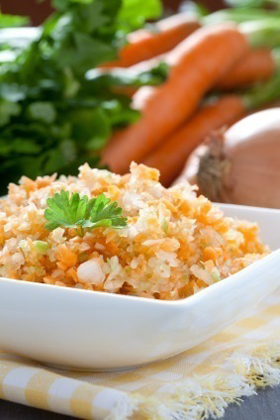
A fresh batch of soffritto, ready to be stored in the fridge. Photo by C. Gissemann | IST. |
Preparation
1. WASH. Wash the vegetables and herbs and pat dry with a paper towel.
2. DICE. Dice them finely. Place them in a jar (one with a tight lid); add the olive oil, vinegar and salt, mixing well. Because vinegar and salt are natural preservatives, the ingredients will keep for a few week.
3. COOK. When ready to prepare a recipe, add the raw soffritto to the pan and sauté over medium-low heat until the vegetables become soft and the onions begin to yellow and the carrots are tender—5 to 7 minutes. Use more more olive oil or white wine, as needed. You don’t want the vegetables to become well done. |
Soffritto Vs. Soffritto
Spanish sofrito is different from Italian/Latin soffritto. In Spain, sofrito, with one “f” and one “t,” is a traditional rustic tomato sauce used as a base for paella, in empanadas and to add flavor to stews and egg tortas.
Lighter than Italian-style tomato sauces, sofrito is made with olive oil, tomatoes, onions, green peppers and garlic—a zingy foundation for countless Spanish dishes. |
|
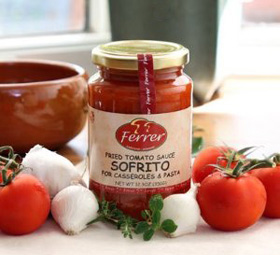
In Spain, sofrito is a rustic tomato sauce. You can find the Goya brand in supermarkets, or buy an artisan brand like this online. |
Do you have friends who would enjoy THE NIBBLE?
Click here to send them an invitation to sign up for their own copy. |
© Copyright 2004-
2025
Lifestyle Direct, Inc. All rights reserved. All information contained herein is subject to change at any time without notice. All details must be directly confirmed with manufacturers, service establishments and other third parties. The material in this webzine may not be reproduced, distributed, transmitted, cached, or otherwise used, except with the prior written permission of Lifestyle Direct, Inc. |
|

|
 |













